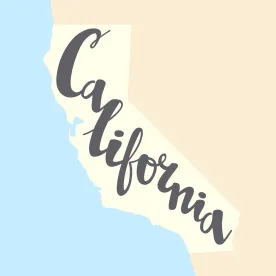A state Court of Appeal decision was released at the same time that this legal insight was published. An updated legal insight reflecting the new decision is available here.
In California, legislators are debating the future of its cap-and-trade program beyond 2020, the state is defending the constitutionality of its existing program in court, and there remains the possibility of a showdown with the federal government over California’s historical Clean Air Act waiver for setting state-specific emissions standards. The California Global Warming Solutions Act of 2006 (“AB 32”), as updated by S.B. 32, requires California to reduce its greenhouse gas (“GHG”) emissions to 1990 levels by 2020 and 40 percent below 1990 levels by 2030.[1] AB 32 explicitly authorizes a “system of market-based declining annual aggregate emission limits” for GHG-emitting sources through the year 2020.[2] The California Air Resources Board (“CARB”) is the lead agency responsible for implementing AB 32’s cap-and-trade program.
In 2012, CARB set a statewide limit on sources responsible for 85 percent of California’s GHG emissions and has reduced that limit by 2 to 3 percent in each subsequent year through 2020. While large industrial facilities and other covered entities were initially given free allowances, most entities must now buy some percentage of allowances that are directly auctioned by CARB or buy such allowances on the secondary market. Each allowance represents a right to emit one ton of GHGs.
California’s cap-and-trade auctions began in 2012 and have brought the state billions of dollars of revenue that is required to be spent on climate change efforts. For instance, one such recipient of cap-and-trade auction funds is the $68 billion bullet train being built between Los Angeles and San Francisco.[3] Over time, the bullet train has received about 25 percent of the auction proceeds.[4] Opponents of cap and trade argue that it is an unconstitutional “tax” because the money raised at auction and spent on things like bullet trains far outweighs the cost of administering AB 32 compliance.[5] In California, laws that fund government services and programs must be approved by two-thirds majorities in both houses of the California State Legislature (i.e., a “supermajority”). According to a lawsuit filed by the California Chamber of Commerce, AB 32’s cap-and-trade program is unconstitutional because it passed with only a simple majority. The case is currently pending before the California Court of Appeal with a decision expected in 60–90 days.
Against the challenge to the existing cap-and-trade program, California continues to press ahead with more ambitious GHG reduction goals, and CARB prefers to use cap and trade to get there, with or without explicit legislative mandate. CARB’s 2017 AB 32 Scoping Plan is currently evaluating several strategies to best position California to meet its 2030 compliance obligations. CARB’s 2017 Scoping Plan proposes extending the cap-and-trade program from a 2020 sunset through 2030, with declining allowances for each year. The 2017 Scoping Plan also analyzes various alternatives to continuing the cap-and-trade program, including the repeal of cap and trade, implementing a carbon tax, and a cap-and-tax scheme. But uncertainties remain, given the concern that AB 32 set 2020 as a deadline to reduce emissions and did not authorize CARB to implement a market-based emissions reduction system beyond that date.[6]
To address these concerns and prevent the program from further legal attacks, Governor Jerry Brown wants both legislative chambers to approve an extension of the state’s cap-and-trade program by a supermajority vote. Governor Brown has said that he will not dole out the estimated $2.2 billion in revenue projected from the cap-and-trade auction until the program is extended.[7] In response, a group of lawmakers introduced AB 151 on January 12, 2017, to extend the cap-and-trade program beyond 2020. While the latest version of the bill allows CARB to continue using cap and trade to meet California’s GHG goals, committee amendments removed language stating it was the “intent of the Legislature” to authorize CARB to use market-based compliance mechanism past 2020.[8] While efforts in 2016 to cement cap and trade into law through 2030 failed, a new democratic supermajority in the California Legislature may bode well for this latest effort to preserve cap and trade in some form.[9]
But another group of lawmakers, including the chairs of the California Assembly Natural Resources Committee and the Utilities and Energy Committee, are more wary of cap and trade because they believe it disproportionately impacts the state’s most disadvantaged communities by allowing companies to keep polluting, so long as they pay a price.[10] Facilities that must comply with California’s cap-and-trade program (such as refineries and food processors) are often located in or upwind of low-income communities.[11] Environmental justice advocates want more stringent regulations that require polluters to reduce emissions at their facilities and prevent companies from applying offsets far away from the communities where the pollution is emitted. On February 9, 2017, lawmakers introduced a different bill to meet the 2030 target, which requires CARB to consider the social cost of GHG emissions in disadvantaged communities.[12]
Given the political and legal uncertainty around California’s cap-and-trade program, revenues from the recent quarterly auctions have been anemic. The February 2017 auction resulted in only 16.5 percent of the 74.8 million metric tons of emissions allowances being sold, leaving some of California’s ambitious climate programs, including the bullet train, underfunded.[13]
Related to California’s low-carbon efforts are CARB’s longstanding regulations requiring stricter-than-federal tailpipe emissions limitations and its efforts to require 15 percent or more of car sales to be zero-emission vehicles by 2025. California has been able to press ahead with these rules under a series of special Clean Air Act legislative and regulatory waivers dating back to the late 1960s, and over time several other states have adopted California’s stricter standards. The Trump administration, however, has indicated recently that it may rethink or revoke California’s special role in setting mobile-source emission limits for a significant chunk of the domestic car market. While California has vowed to fight any efforts to rollback its waivers, and has accumulated decades of precedent to show the efficacy of its emissions standards, a showdown with the new federal administration could inject considerable uncertainty into the U.S. auto market.
Conclusion
California’s experience with carbon policy is sure to complicate matters along the West Coast. The questions surrounding its program will certainly have an effect on programs in nearby states in light of the disproportionate size of the California economy and other states’ willingness to follow CARB’s emissions standards. For this reason, it may be challenging for entities that operate across the West to comply with the various requirements for each state. We will continue to monitor and report on legal, policy, and industry developments driven by carbon pricing programs in California and across the country.
This is the final installment in a three-part series examining carbon policies along the West Coast. Read more about carbon policy in Washington, which continues to consider a carbon tax and defend its Clean Air Rule, and Oregon, where lawmakers are considering carbon pricing legislation.
[1] Cal. Health & Safety Code § 38500 et seq.
[2] Cal. Health & Safety Code § 38562(c).
[3] Chris Megerian, The immediate threat to California’s climate-change fight isn’t Trump, it’s this, L.A. Times (Jan. 22, 2017), http://www.latimes.com/politics/la-pol-ca-california-climate-lawsuit-20170122-story.html.
[4] Chris Megerian, California’s cap-and-trade program faces daunting hurdles to avoid collapse, L.A. Times (June 14, 2016), http://www.latimes.com/politics/la-pol-sac-climate-change-challenges-20160614-snap-story.html.
[5] See Cal. Chamber of Commerce v. Cal. Air Res. Bd., No. C075930 (Cal. Ct. App. Jan. 24, 2017). The California Court of Appeal for the Third Appellate District in Sacramento heard oral argument on January 24, 2017, and has until April 24, 2017, to issue a ruling.
[6] Chris Megerian, Here’s what you should know about this year’s debate over California’s cap-and-trade program, L.A. Times (Feb. 9, 2017), http://www.latimes.com/politics/la-pol-sac-cap-trade-debate-20170209-htmlstory.html.
[7] Chris Megerian, Gov. Jerry Brown pushes to extend cap-and-trade program with new budget proposal, L.A. Times (Jan. 10, 2017), http://www.latimes.com/politics/essential/la-pol-ca-essential-politics-updates-gov-jerry-brown-wants-1484075600-htmlstory.html.
[8] AB 151, 2017–18 Leg. Sess. (Cal. 2017).
[9] See Anne C. Mulkern, Climate Action May Be Boosted by California’s Democratic Supermajority, Sci. Am. (Dec. 5, 2016),https://www.scientificamerican.com/article/climate-action-may-be-boosted-by-californias-democratic-supermajority/.
[10] Chris Megerian, Here’s what you should know about this year’s debate over California’s cap-and-trade program, L.A. Times (Feb. 9, 2017), http://www.latimes.com/politics/la-pol-sac-cap-trade-debate-20170209-htmlstory.html.
[11] See, e.g., Emily Guerin, Environmental Groups Say California’s Climate Program Has Not Helped Them, NPR (Feb. 24, 2017), http://www.npr.org/2017/02/24/515379885/environmental-groups-say-californias-climate-program-has-not-helped-them.
[12] AB 378, 2017-18 Leg. Sess. (Cal. 2017).
[13] Dan Walters, California’s cap and trade auction another washout, Sacramento Bee (March 1, 2017), http://www.sacbee.com/news/politics-government/capitol-alert/article135781558.html.





 />i
/>i

